Zhongweiyang Xu
Contrastive Diffusion Guidance for Spatial Inverse Problems
Sep 30, 2025

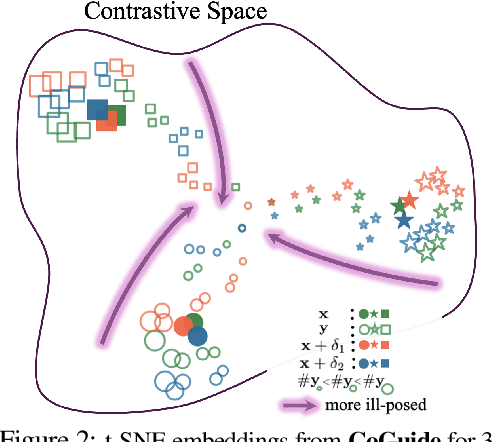

Abstract:We consider the inverse problem of reconstructing the spatial layout of a place, a home floorplan for example, from a user`s movements inside that layout. Direct inversion is ill-posed since many floorplans can explain the same movement trajectories. We adopt a diffusion-based posterior sampler to generate layouts consistent with the measurements. While active research is in progress on generative inverse solvers, we find that the forward operator in our problem poses new challenges. The path-planning process inside a floorplan is a non-invertible, non-differentiable function, and causes instability while optimizing using the likelihood score. We break-away from existing approaches and reformulate the likelihood score in a smoother embedding space. The embedding space is trained with a contrastive loss which brings compatible floorplans and trajectories close to each other, while pushing mismatched pairs far apart. We show that a surrogate form of the likelihood score in this embedding space is a valid approximation of the true likelihood score, making it possible to steer the denoising process towards the posterior. Across extensive experiments, our model CoGuide produces more consistent floorplans from trajectories, and is more robust than differentiable-planner baselines and guided-diffusion methods.
ArrayDPS: Unsupervised Blind Speech Separation with a Diffusion Prior
May 17, 2025Abstract:Blind Speech Separation (BSS) aims to separate multiple speech sources from audio mixtures recorded by a microphone array. The problem is challenging because it is a blind inverse problem, i.e., the microphone array geometry, the room impulse response (RIR), and the speech sources, are all unknown. We propose ArrayDPS to solve the BSS problem in an unsupervised, array-agnostic, and generative manner. The core idea builds on diffusion posterior sampling (DPS), but unlike DPS where the likelihood is tractable, ArrayDPS must approximate the likelihood by formulating a separate optimization problem. The solution to the optimization approximates room acoustics and the relative transfer functions between microphones. These approximations, along with the diffusion priors, iterate through the ArrayDPS sampling process and ultimately yield separated voice sources. We only need a simple single-speaker speech diffusion model as a prior along with the mixtures recorded at the microphones; no microphone array information is necessary. Evaluation results show that ArrayDPS outperforms all baseline unsupervised methods while being comparable to supervised methods in terms of SDR. Audio demos are provided at: https://arraydps.github.io/ArrayDPSDemo/.
Unsupervised Blind Speech Separation with a Diffusion Prior
May 08, 2025Abstract:Blind Speech Separation (BSS) aims to separate multiple speech sources from audio mixtures recorded by a microphone array. The problem is challenging because it is a blind inverse problem, i.e., the microphone array geometry, the room impulse response (RIR), and the speech sources, are all unknown. We propose ArrayDPS to solve the BSS problem in an unsupervised, array-agnostic, and generative manner. The core idea builds on diffusion posterior sampling (DPS), but unlike DPS where the likelihood is tractable, ArrayDPS must approximate the likelihood by formulating a separate optimization problem. The solution to the optimization approximates room acoustics and the relative transfer functions between microphones. These approximations, along with the diffusion priors, iterate through the ArrayDPS sampling process and ultimately yield separated voice sources. We only need a simple single-speaker speech diffusion model as a prior along with the mixtures recorded at the microphones; no microphone array information is necessary. Evaluation results show that ArrayDPS outperforms all baseline unsupervised methods while being comparable to supervised methods in terms of SDR. Audio demos are provided at: https://arraydps.github.io/ArrayDPSDemo/.
Multi-Source Music Generation with Latent Diffusion
Sep 10, 2024
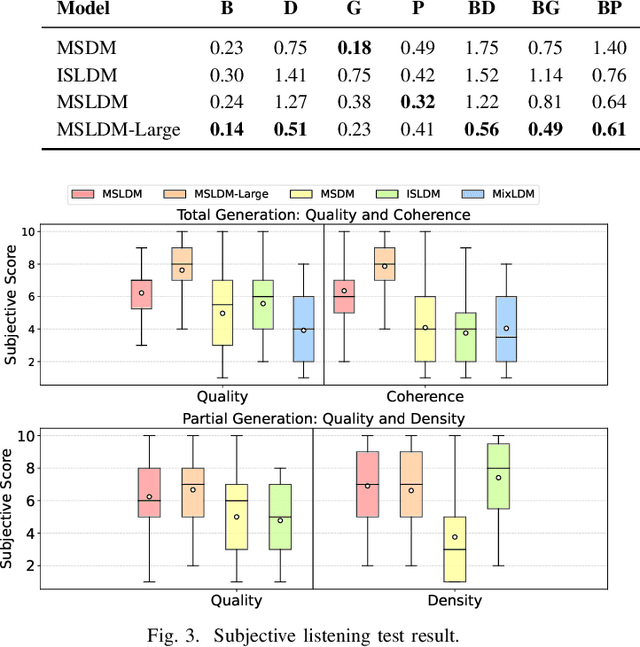


Abstract:Most music generation models directly generate a single music mixture. To allow for more flexible and controllable generation, the Multi-Source Diffusion Model (MSDM) has been proposed to model music as a mixture of multiple instrumental sources (e.g., piano, drums, bass, and guitar). Its goal is to use one single diffusion model to generate consistent music sources, which are further mixed to form the music. Despite its capabilities, MSDM is unable to generate songs with rich melodies and often generates empty sounds. Also, its waveform diffusion introduces significant Gaussian noise artifacts, which compromises audio quality. In response, we introduce a multi-source latent diffusion model (MSLDM) that employs Variational Autoencoders (VAEs) to encode each instrumental source into a distinct latent representation. By training a VAE on all music sources, we efficiently capture each source's unique characteristics in a source latent that our diffusion model models jointly. This approach significantly enhances the total and partial generation of music by leveraging the VAE's latent compression and noise-robustness. The compressed source latent also facilitates more efficient generation. Subjective listening tests and Frechet Audio Distance (FAD) scores confirm that our model outperforms MSDM, showcasing its practical and enhanced applicability in music generation systems. We also emphasize that modeling sources is more effective than direct music mixture modeling. Codes and models are available at https://github.com/XZWY/MSLDM. Demos are available at https://xzwy.github.io/MSLDMDemo.
FoVNet: Configurable Field-of-View Speech Enhancement with Low Computation and Distortion for Smart Glasses
Aug 12, 2024


Abstract:This paper presents a novel multi-channel speech enhancement approach, FoVNet, that enables highly efficient speech enhancement within a configurable field of view (FoV) of a smart-glasses user without needing specific target-talker(s) directions. It advances over prior works by enhancing all speakers within any given FoV, with a hybrid signal processing and deep learning approach designed with high computational efficiency. The neural network component is designed with ultra-low computation (about 50 MMACS). A multi-channel Wiener filter and a post-processing module are further used to improve perceptual quality. We evaluate our algorithm with a microphone array on smart glasses, providing a configurable, efficient solution for augmented hearing on energy-constrained devices. FoVNet excels in both computational efficiency and speech quality across multiple scenarios, making it a promising solution for smart glasses applications.
uSee: Unified Speech Enhancement and Editing with Conditional Diffusion Models
Oct 02, 2023Abstract:Speech enhancement aims to improve the quality of speech signals in terms of quality and intelligibility, and speech editing refers to the process of editing the speech according to specific user needs. In this paper, we propose a Unified Speech Enhancement and Editing (uSee) model with conditional diffusion models to handle various tasks at the same time in a generative manner. Specifically, by providing multiple types of conditions including self-supervised learning embeddings and proper text prompts to the score-based diffusion model, we can enable controllable generation of the unified speech enhancement and editing model to perform corresponding actions on the source speech. Our experiments show that our proposed uSee model can achieve superior performance in both speech denoising and dereverberation compared to other related generative speech enhancement models, and can perform speech editing given desired environmental sound text description, signal-to-noise ratios (SNR), and room impulse responses (RIR). Demos of the generated speech are available at https://muqiaoy.github.io/usee.
Unifying Robustness and Fidelity: A Comprehensive Study of Pretrained Generative Methods for Speech Enhancement in Adverse Conditions
Sep 16, 2023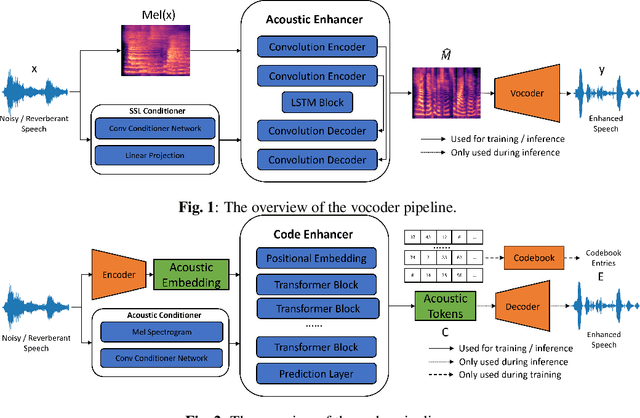

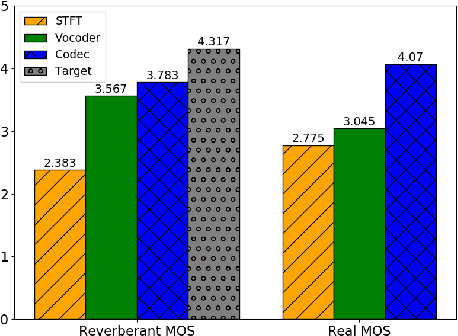
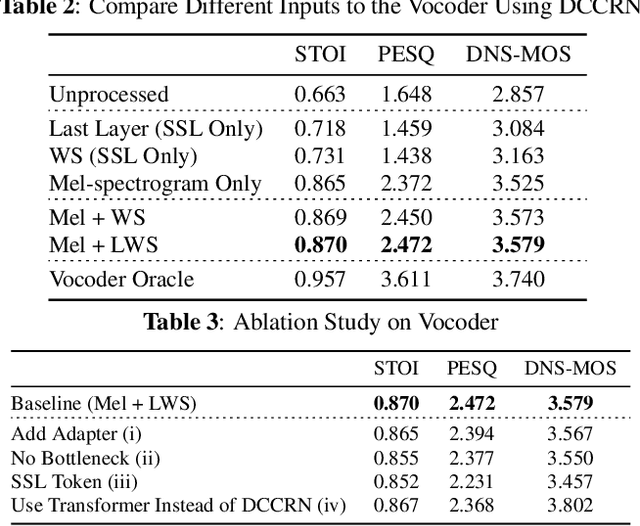
Abstract:Enhancing speech signal quality in adverse acoustic environments is a persistent challenge in speech processing. Existing deep learning based enhancement methods often struggle to effectively remove background noise and reverberation in real-world scenarios, hampering listening experiences. To address these challenges, we propose a novel approach that uses pre-trained generative methods to resynthesize clean, anechoic speech from degraded inputs. This study leverages pre-trained vocoder or codec models to synthesize high-quality speech while enhancing robustness in challenging scenarios. Generative methods effectively handle information loss in speech signals, resulting in regenerated speech that has improved fidelity and reduced artifacts. By harnessing the capabilities of pre-trained models, we achieve faithful reproduction of the original speech in adverse conditions. Experimental evaluations on both simulated datasets and realistic samples demonstrate the effectiveness and robustness of our proposed methods. Especially by leveraging codec, we achieve superior subjective scores for both simulated and realistic recordings. The generated speech exhibits enhanced audio quality, reduced background noise, and reverberation. Our findings highlight the potential of pre-trained generative techniques in speech processing, particularly in scenarios where traditional methods falter. Demos are available at https://whmrtm.github.io/SoundResynthesis.
SpatialCodec: Neural Spatial Speech Coding
Sep 14, 2023


Abstract:In this work, we address the challenge of encoding speech captured by a microphone array using deep learning techniques with the aim of preserving and accurately reconstructing crucial spatial cues embedded in multi-channel recordings. We propose a neural spatial audio coding framework that achieves a high compression ratio, leveraging single-channel neural sub-band codec and SpatialCodec. Our approach encompasses two phases: (i) a neural sub-band codec is designed to encode the reference channel with low bit rates, and (ii), a SpatialCodec captures relative spatial information for accurate multi-channel reconstruction at the decoder end. In addition, we also propose novel evaluation metrics to assess the spatial cue preservation: (i) spatial similarity, which calculates cosine similarity on a spatially intuitive beamspace, and (ii), beamformed audio quality. Our system shows superior spatial performance compared with high bitrate baselines and black-box neural architecture. Demos are available at https://xzwy.github.io/SpatialCodecDemo. Codes and models are available at https://github.com/XZWY/SpatialCodec.
Learning to Separate Voices by Spatial Regions
Jul 15, 2022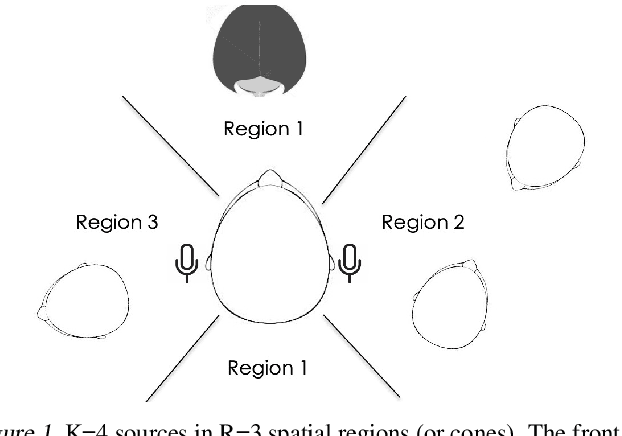


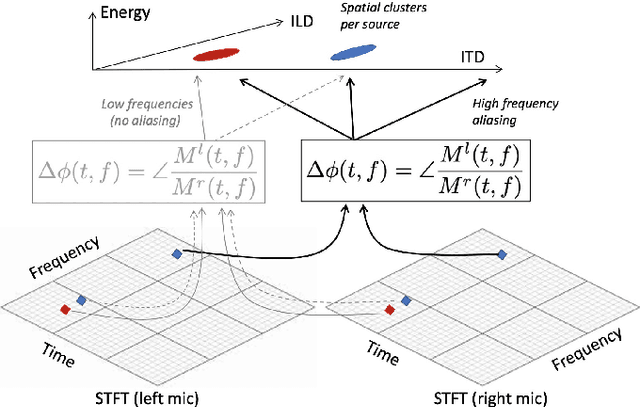
Abstract:We consider the problem of audio voice separation for binaural applications, such as earphones and hearing aids. While today's neural networks perform remarkably well (separating $4+$ sources with 2 microphones) they assume a known or fixed maximum number of sources, K. Moreover, today's models are trained in a supervised manner, using training data synthesized from generic sources, environments, and human head shapes. This paper intends to relax both these constraints at the expense of a slight alteration in the problem definition. We observe that, when a received mixture contains too many sources, it is still helpful to separate them by region, i.e., isolating signal mixtures from each conical sector around the user's head. This requires learning the fine-grained spatial properties of each region, including the signal distortions imposed by a person's head. We propose a two-stage self-supervised framework in which overheard voices from earphones are pre-processed to extract relatively clean personalized signals, which are then used to train a region-wise separation model. Results show promising performance, underscoring the importance of personalization over a generic supervised approach. (audio samples available at our project website: https://uiuc-earable-computing.github.io/binaural/. We believe this result could help real-world applications in selective hearing, noise cancellation, and audio augmented reality.
Dual-path Attention is All You Need for Audio-Visual Speech Extraction
Jul 09, 2022
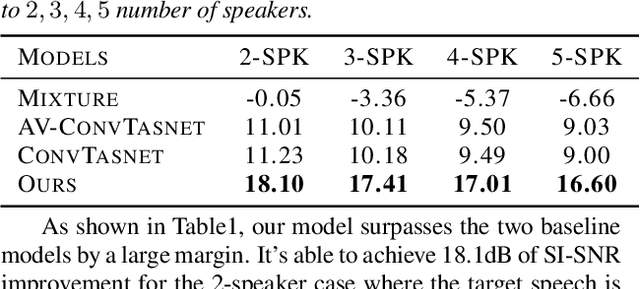
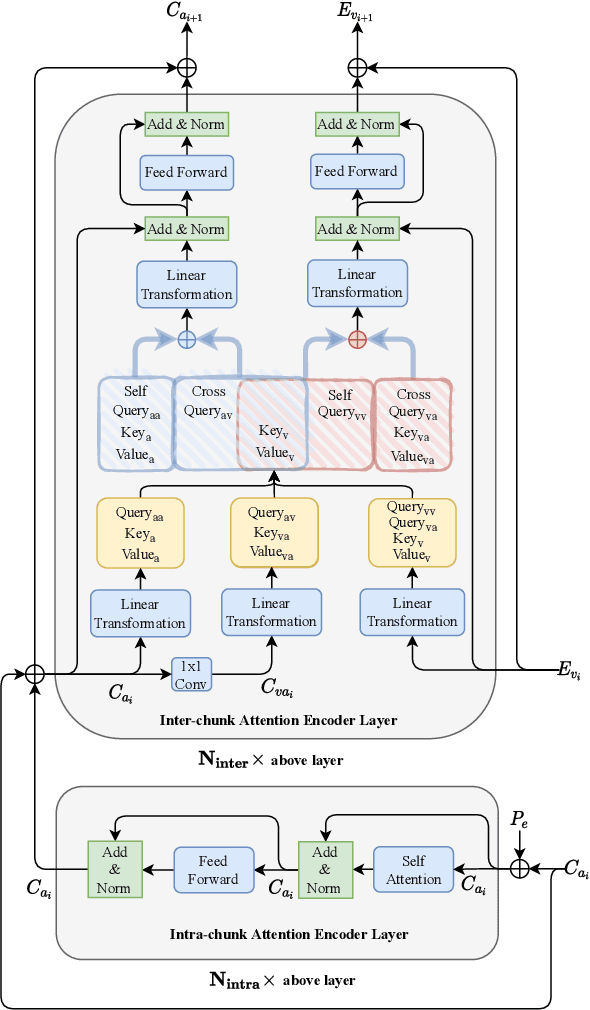
Abstract:Audio-visual target speech extraction, which aims to extract a certain speaker's speech from the noisy mixture by looking at lip movements, has made significant progress combining time-domain speech separation models and visual feature extractors (CNN). One problem of fusing audio and video information is that they have different time resolutions. Most current research upsamples the visual features along the time dimension so that audio and video features are able to align in time. However, we believe that lip movement should mostly contain long-term, or phone-level information. Based on this assumption, we propose a new way to fuse audio-visual features. We observe that for DPRNN \cite{dprnn}, the interchunk dimension's time resolution could be very close to the time resolution of video frames. Like \cite{sepformer}, the LSTM in DPRNN is replaced by intra-chunk and inter-chunk self-attention, but in the proposed algorithm, inter-chunk attention incorporates the visual features as an additional feature stream. This prevents the upsampling of visual cues, resulting in more efficient audio-visual fusion. The result shows we achieve superior results compared with other time-domain based audio-visual fusion models.
 Add to Chrome
Add to Chrome Add to Firefox
Add to Firefox Add to Edge
Add to Edge